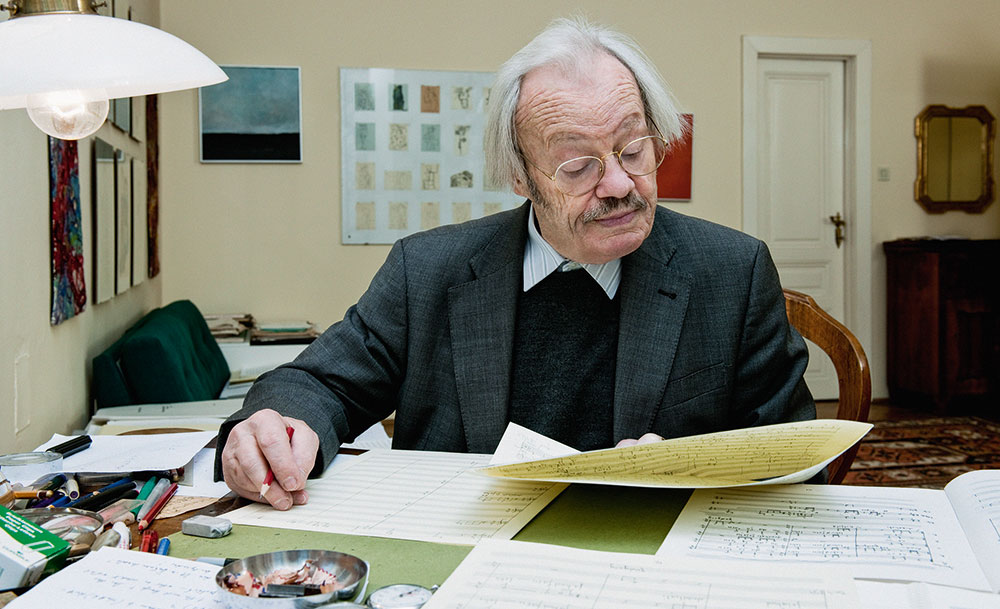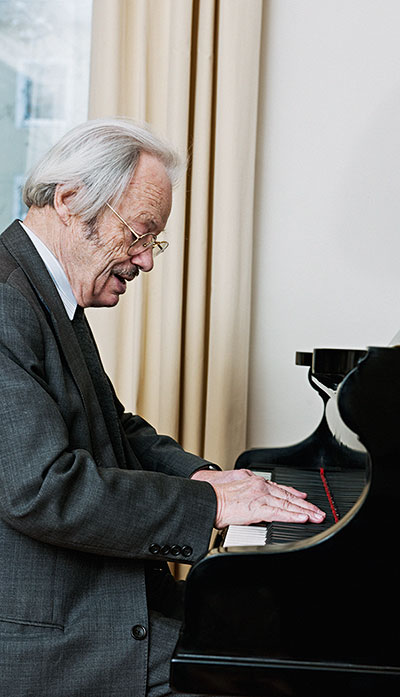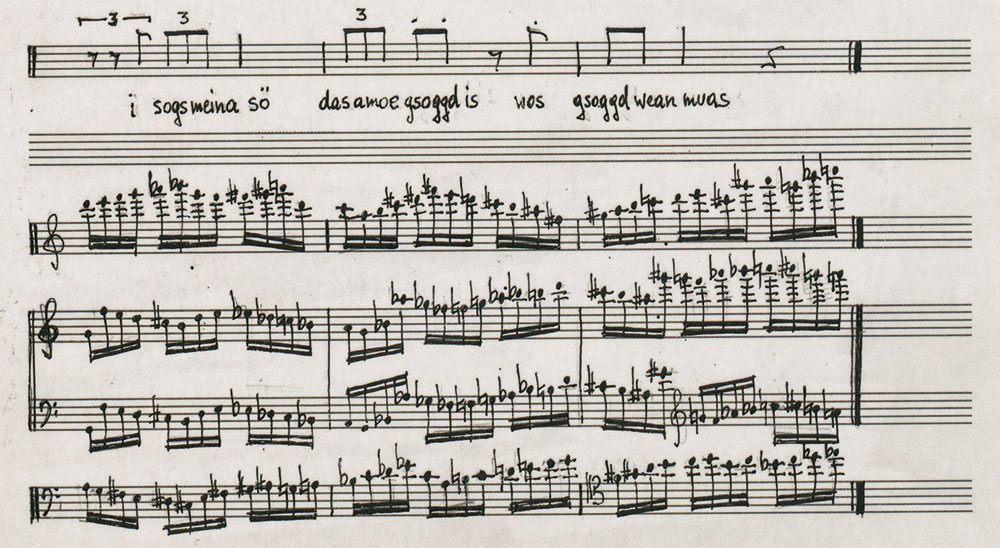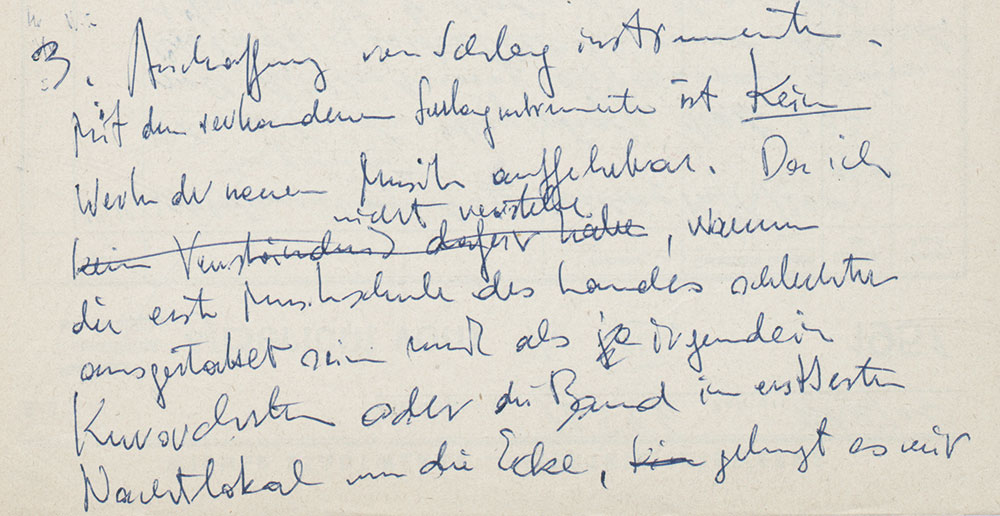Every summer semester, the Joseph Haydn Department invites a prominent composer to prepare one of her or his own works with mdw instrumentalists. This year, the Webern Ensemble Wien—under the artistic direction of Jean-Bernard Matter—turns to the doyen of Austrian composing: Friedrich Cerha. His life’s work encompasses over seven decades of output in all contemporary musical genres.


“You’re using our tools to make ancient music!” This is what Luigi Nono is supposed to have remarked with consternation following the performance of a piece by Friedrich Cerha. That was in Darmstadt in 1958, after Cerha had appeared with Iván Eröd to perform his two new works Deux éclats en réflexion and Formation et solution for violin and piano as part of the Darmstadt International Summer Courses for New Music. It’s clear that the fact that both compositions allowed something like musical development to be discerned was not exactly en vogue at what was then a centre for serial music—but for Cerha, it was a premise of his work from which he was unwilling to back down. “This is why technical processes such as composing in tone rows have to this day remained but a means to an end for me, an instrument via which to realise sonic fantasies,” said the composer in a recent interview.
Friedrich Cerha, who turned 93 this year, can look back on around 85 years of experience as a composer—with the earliest work in his catalogue being a Duo for 2 Violins dated 1934. This piece and the Gschwandtner Tänze that Cerha wrote when he was twelve are tied to the composer’s early musical socialisation as a violinist in the wine cellars of Hernals. Decades later, in his “Viennese” works of the 1980s like the Keintaten and Eine Art Chansons after texts by Ernst Jandl and other poets of the Wiener Gruppe, Cerha revisited this genre in a different form. Cross-connections, references to earlier material, and inter-musical connections of this sort typify Cerha’s versatility in terms of compositional expression.


The composer’s own perspective on his output changes with temporal distance: “There are things from the 1950s that I still feel very close to today, and there are works from the 1970s that I’ve already half-forgotten,” said the composer on his 90th birthday. Constantly present, he said, is the seven part orchestral cycle Spiegel, which he composed in 1960/61. As one of the first compositions in which he employed large-scale sound surfaces, Spiegel represented an important turning point for more than just Cerha’s own composing. It was during the period in which these fundamental works were composed that Cerha began teaching at the Academy (today’s University) of Music and Performing Arts Vienna, where he headed the Practicum for Contemporary Music and—later on—the Special Programme for Electronic Music. In 1976, he became a full professor of composition, notation, and interpretation of contemporary music, and the list of his students would come to include Karlheinz Essl, Christian Ofenbauer, and Georg Friedrich Haas.
If one looks through the extensive materials with regard to Cerha’s activities at the mdw that he’s already donated for archival purposes, one finds things such as his evaluations of Friedrich Wildgans, Hanns Jelinek, and Karl Schiske (done as part of the search process to fill a teaching post) as well as a grant request for continued work on the “akaphon”, the electronic instrument invented at the Electro-Acoustic Studio and now on display at Technisches Museum Wien (the Vienna Technical Museum). The numerous handwritten documents also include one linked to a 1966 exposé in which Cerha advocated things including the percussion classes’ participation in his practicum and the procurement of percussion instruments—with success, by the way. Beneath the heading “Zum Problem eines sinnvollen Unterrichts in Neuer Musik an unserer Hochschule” [On the Problem of Sensible Instruction in Contemporary Music at our Academy], Cerha—in his usual direct and pointed manner—asks “why this country’s foremost music school has to be equipped worse than some spa orchestra or the band that plays in the first-best nightclub around the corner […]”, holding that contemporary works simply could not be played using only the instruments present onsite.

In keeping with this is an activity report concerning the Practicum for Contemporary Music, in which Cerha makes clear how important it is for new music to simply be played—“openly, unburdened by prejudices, and free from the ballast of theoretical or pseudo-academic buzzwords”. And while this can be read historically as a reaction to then-current trends in contemporary music, Cerha’s formulations from 1959 still seem valid and up to date: “Intellectual contact is certainly of eminent importance, but in order to gain access with one’s senses—and this is the prerequisite for authentic affection—one needs to hold one’s instrument in one’s own hand.”
- The Vorlass of Friedrich Cerha is accessible to the public at the Archive of Contemporary Arts – Collection of Literary Estates at Danube University Krems.
archivderzeitgenossen.at - A recording of Friedrich Cerha’s Eine Art Chansons with HK Gruber as chansonnier was released recently by Kairos.
kairos-music.com
Event tip
Portrait concerts with Friedrich Cerha incl. composer’s talk
Wednesday, 22 May 2019, 6.00 pm
Arnold Schönberg Center
Zaunergasse 1-3
1030 Vienna
Friday, 24 May 2019, 6.00 pm
Joseph Haydn Hall
mdw – University of Music and Performing Arts Vienna
Anton-von-Webern-Platz 1
1030 Vienna

